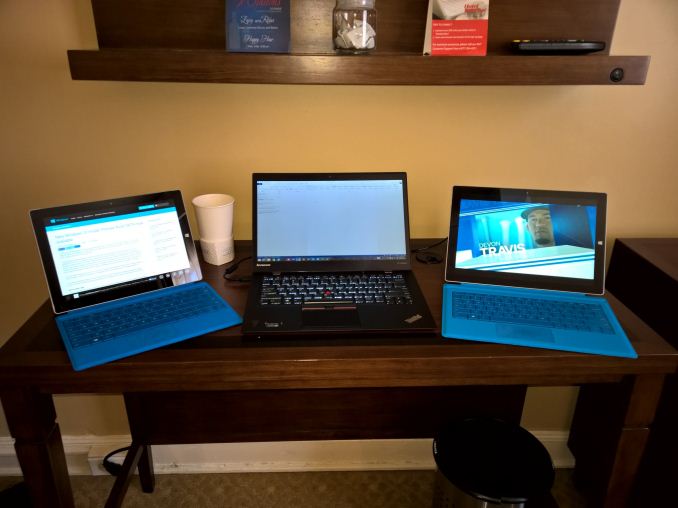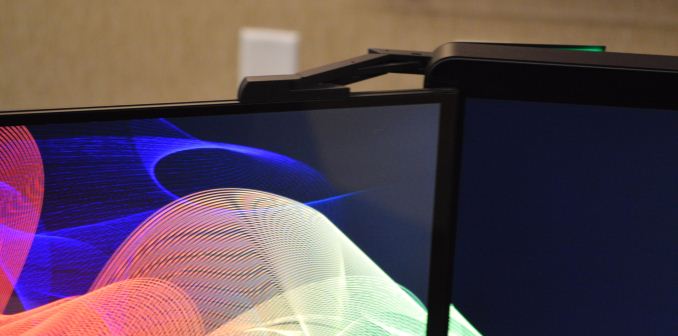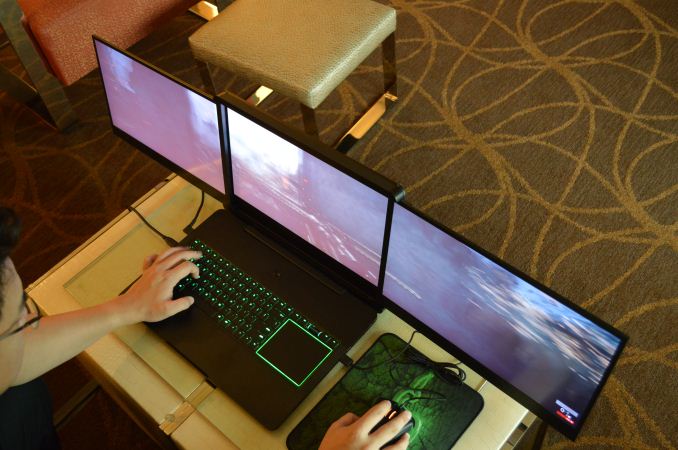Razer Reveals Their Triple Monitor Gaming Laptop Concept: Project Valerie
by Brett Howse on January 5, 2017 9:00 AM EST- Posted in
- Laptops
- CES
- Razer
- Trade Shows
- NVIDIA
- IGZO
- G-Sync
- Razer Blade Pro
- CES 2017

What do you do after you’ve launched one of the thinnest and lightest gaming laptops featuring the new NVIDIA GTX 1080 GPU? Razer found itself in this situation after announcing the long anticipated update to their large gaming laptop last year, with the launch of the Razer Blade Pro. At 7.8 lbs and 0.88 inches thick, it’s one of the most interesting gaming laptops announced last year, and our full review is coming soon. Meanwhile, Razer decided to take their Razer Blade Pro, and add two more displays to it.
Today Razer is announcing Project Valerie, which is the world’s first portable laptop with three built-in displays. To do this, they didn’t make the main display smaller either. All three displays are 17.3-inch UHD (3840x2160) IGZO panels with 100% Adobe RGB coverage. I’ll leave the discussion on why 100% Adobe RGB isn’t a great experience for another day, but with the three displays, you get a 11,520 x 2160 resolution experience with Project Valerie. Since this is going to be a struggle to drive even with the best GPU, all three displays also support G-SYNC. The displays themselves have a motorized hinge to put them into position, and they slide back and slide under the main panel when stowed. It’s an interesting feat of engineering.
Just to be clear, this is currently just a prototype, but yesterday at CES Ryan Smith was able to visit Razer and check out this project. Razer has a couple of prototypes - ranging from proof-of-concept designs to the final industrial design - and not all of them have the movable displays, but they were functioning prototypes. One of the proof-of-concept prototypes was even playing Battlefield 1 in a full 180° NVIDIA Surround View gaming setup.
Razer is building this system as a mobile workhorse, and by starting with the Razer Blade Pro, they already have a thin and light system for the amount of compute available. Final specifications are not complete yet for the dimensions and weight, but Project Valerie with its triple monitors will be in the same aluminum CNC chassis format as the other Razer laptops, with a thickness of just 1.5-inches, and a final weight between 10 and 12 pounds, which is really not much different than many other 17.3-inch gaming notebooks.
This would be excellent for an office user, where the extra display real estate would make multitasking much easier, and any of us who leverage multiple monitors regularly, like I do, can see this being an amazingly portable office machine too. One of the things I hate most about using a laptop on the road is that it only has a single display, making it difficult to get work done. Often I have to resort to crazy things like bringing multiple devices on a road trip for proper workflow, as seen below.
 What I need to do now to get three displays on the road
What I need to do now to get three displays on the road
The basis of Project Valerie is the Razer Blade Pro, with a quad-core i7 mobile CPU, NVIDIA GTX 1080, and plenty of RAM, at least for the prototypes, and this may change later. For outright gaming, the single GTX 1080 is going to struggle with this kind of resolution of course, but if and when this comes to production we’ll see what Razer can do about that. It also features the ultra-low-profile mechanical keyboard from the Pro, with per-key RGB backlighting and Chroma support.
Although this is just a concept, it’s a very interesting concept, and if properly executed it could be a very exciting machine. For the time being, it is being shown at CES as a working prototype, which means it’s possible it may be put into production. Time will tell.
Source: Razer



















32 Comments
View All Comments
BrokenCrayons - Thursday, January 5, 2017 - link
The point that any current GPU will be unable to drive three 4K screens and maintain a reasonable framerate in games stands. A 1080, although the current top end, isn't going to be able to do it. I expect even SLI 1080 wouldn't cut it in current games let alone things that will invariably come out in the near future that drive system requirements up. Sure it'll be okay for things like MS Word and e-mail, but Razer's target market has historically been gamers. People looking for multi monitor support for more mundane tasks will do so with cheaper desktop monitors rather than "gaming" notebooks.close - Thursday, January 5, 2017 - link
I can't say much about a SLI setup but I can tell you that a single 1080 with a triple 4K screen setup the performance was unbearable :). I expect a second card would help a lot but I wouldn't expect anything close or above 30FPS in games except for those that are really not demanding.I had around 10-15FPS in most of the popular games unless i really dropped quality which would make it an exercise in futility anyway.
peterfares - Thursday, January 5, 2017 - link
Is there even any desktop GPU that can handle 3 4K screens smoothly?I guess you always have the option of gaming at a lower resolution or with just one screen. This thing would be a beastly mobile workstation.
virtuastro - Thursday, January 5, 2017 - link
Most PC hardcore simulators and racing games do 3 x 4K screens really smoothly. Many times I've seen them on youtube for 3 x 4K screens with a gtx 960 to 980ti. Almost all simulation racing games don't have most graphic intensive.BrokenCrayons - Thursday, January 5, 2017 - link
That's one scenario of many that a gaming-oriented computer will be subjected to and while it's a valid point (probably anyway...I haven't bothered looking into the idea of a 9x0 GPU driving three 4k displays) it's not the only scenario. Simulators that attempt to accurately portray something like say flying an aircraft and racing games are a subset of a larger software library and if something like this system of Razer's does go into production, there will be an expectation it can run other more mainstream titles that will result in poor performance. As suggested in another post below this, 1080p makes a lot more sense and would probably be a better overall experience for the person on the keyboard. 4K resolutions, while better, approach the point of diminishing returns on smaller screens anyway so there's not as much value in the increased resolution over 1080 as 1080 is over something like 720.inperfectdarkness - Friday, January 6, 2017 - link
Then why wouldn't a single GTX 1080 be able to handle it? Every benchmark I've seen on the 10 series pegs it SUBSTANTIALLY better than the 9 series--and the laptop cards being virtually identical to their desktop counterparts in performance.Despite what the dirty philistines say, 1080p would be woefully underwheliming. Even if I had to run "moderate" graphic settings on my games, I'd rather do that at the 4k resolution--than "ultra" at 1080p.
BrokenCrayons - Sunday, January 8, 2017 - link
If this thing makes it to retail channels with its current specifications, no one here will stop you from purchasing one to find out for yourself if a 1080 is substantially better enough to give you a satisfactory experience. I'm certainly curious about how it would turn out, but I don't expect this will end up going on sale so I'll defer to close's post which already describes an inadequate gaming experience using a desktop 1080 and three 4K screens.KompuKare - Thursday, January 5, 2017 - link
Interesting concept, but for on the go office use I wouldn't use a gaming laptop plus I like serviceability.Maybe Lenovo are interested in reviving the ThinkPad W701ds dual-screen laptop (although dual in this case meant a 17" 1200P screen with a 768*1280 side screen)?
http://www.thinkwiki.org/wiki/Category:w701ds
jwcalla - Thursday, January 5, 2017 - link
The tech industry has gone full retard.Michael Bay - Thursday, January 5, 2017 - link
Yep, and then you can always count on Razer for the oneupping of the trend!